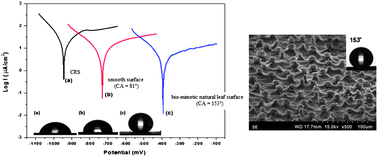In this study, a UV-curing nanocasting technique was first used to develop advanced anticorrosive coatings with bio-mimetic Xanthosoma sagittifolium leaf-like, non-fluorinated, super-hydrophobic polymeric surfaces. First of all, a transparent soft template with negative patterns of Xanthosoma sagittifolium leaf was fabricated by thermally curing the PDMS pre-polymer in molds at 60 °C for 4 h, followed by detaching the PDMS template from the surface of the natural leaf. Epoxy-acrylate coatings with biomimetic structures were prepared by performing the UV-radiation process after casting UV-curable precursor with photo-initiator onto a cold-rolled steel (CRS) electrode using the PDMS template. Subsequently, the UV-radiation process was carried out by using a light source with an intensity of 100 mW cm2 with an exposing wavelength of 365 nm. The surface morphology of as-synthesized epoxy-acrylate coatings obtained from this UV-curing nanocasting technique was found to have lots of micro-scaled mastoids, each decorated with many nano-scaled wrinkles and was investigated systematically by scanning electron microscopy (SEM) and atomic force microscopy (AFM). It should be noted that the water contact angle (CA) of coating with bio-mimetic natural leaf surface was 153°, which was found to significantly higher than that of the corresponding polymer with a smooth surface (i.e., CA = 81°). The significant increase of the contact angle indicated that this bio-mimetic morphology exhibited effectively water-repelling properties, implying that it may be a potential candidate as advanced anticorrosive coating materials, which can be identified by series of electrochemical corrosion measurements. For example, it should be noted that the corrosion potential (Ecorr) and corrosion current (Icorr), respectively, was found to shift from Ecorr = −730 mV and Icorr = 5.44 μA cm−2 of coating with smooth surface (SS) to Ecorr = −394 mV and Icorr = 2.30 μA cm−2 of coating with biomimetic super-hydrophobic surface (SPS).

You have access to this article
 Please wait while we load your content...
Something went wrong. Try again?
Please wait while we load your content...
Something went wrong. Try again?


 Please wait while we load your content...
Please wait while we load your content...